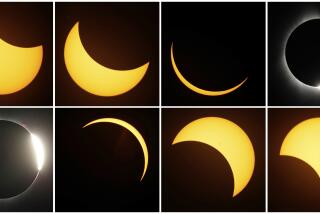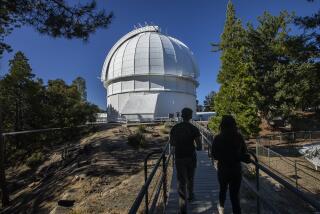Probing a centuries-old mystery in the stars
- Share via
As night settles upon Mt. Wilson, stars rise out of the December darkness and the wind begins to howl.
Brian Kloppenborg looks overhead. There’s Polaris and in the northeast, the Big Dipper, all bright and twinkling to the naked eye, but to the telescopes on this summit, they are smudges, their light blurred by the blustery streams of air and dust. If this keeps up, observing tonight will be impossible.
“There,” he says. “It’s just to right of Capella. See it?”
He aims a flashlight high above a horizon of swaying pines and firs in the direction of a flickering star, faint enough to be easily overlooked.
“That’s it — Epsilon Aurigae,” he says with an almost paternal air.
If he’s disappointed by the conditions tonight, he’s not showing it. He’ll be up here for another night and he’s been lucky so far. Since 2008, he has studied this distant neighbor of Earth with great success.
Lying in the swirls of the Milky Way 2,000 light-years away, Epsilon Aurigae (pronounced EP-si-lon au-RYE-gee) has long puzzled observers with its strange fluctuations of light. After seven visits to this summit, using one of the most sophisticated arrays of telescopes in the world, Kloppenborg, with the help of other astronomers, is slowly unraveling the mystery of this star.
The findings so far have earned him a small measure of fame — publication in the science journal, Nature — and have lent Epsilon Aurigae celebrity status in astronomy circles. It is the focus of both amateur and professional astronomers around the world, a lyric in a rock ballad, “We Are the Stars” and inspiration for artwork that would make Spock proud.
Once merely an odd sounding name in the broad panoply of night, Epsilon Aurigae came to prominence almost 200 years ago when a sharp-eyed government minister looked above the German countryside and noticed something strange in the crowded sky. The star, fifth brightest in the constellation Auriga, had dimmed.
“Has anyone else seen this?” Johann Fritsch wrote in letter to a publisher of star almanacs. The question soon became a challenge to the astronomers of the day, who in time recorded that every 27.1 years, Epsilon Aurigae lost half its brightness for nearly two years.
They tried to explain the phenomenon as a system of stars, one orbiting the other in a long, leisurely ellipse, but something didn’t make sense. When one of the objects passed in front of the other, the light didn’t behave as it did in other binary systems.
Perhaps, the astronomers argued, the eclipse was caused by something other than a star, and with each eclipse, new theories tried to explain the fluctuations of light.
A swarm of meteorites, said one astrophysicist.
A black hole, said another.
A large and dusty cloud.
Or a disk like the rings of Saturn.
But no one knew because from the perspective of Earth, Epsilon Aurigae, like all stars, is not an object but a pinpoint of light whose specific dimensions and shape could only be derived mathematically, and sometimes the numbers can be off.
If only it could be seen more clearly.
::
Kloppenborg steps inside a small building on Mt. Wilson. Sitting in an alcove in the glow of six computer monitors, P.J. Sallave-Goldfinger operates the telescopes that he will use. She isn’t about to open any of them. Dust, flying pine needles and condensation might spoil the mirrors’ surfaces.
Perched more than a mile above Los Angeles, Mt. Wilson has always been valued for its location. More nights than not, the air from the Pacific flows smoothly over the mountains, and a number of universities maintain telescopes here, including Georgia State University with its Center for High Angular Resolution Astronomy.
The CHARA array is an optical interferometer, a fancy name for six, widely spaced telescopes and a labyrinth of trolleys, mirrors and vacuum-sealed conduits that brings starlight into stunningly precise resolution. If someone were to build a Wal-Mart on Mars, CHARA could count the parking spaces.
Focused on a star system 2,000 light-years away, the array allows astronomers like Kloppenborg to define its specific properties.
“We are in a period when it is becoming possible to see star systems in detail,” says science writer Timothy Ferris. “One reason these studies are important is because they shed light on how our star and our planet got here — and the story of how the Earth got here is also the story of how human beings came to be here.”
When the article in Nature came out in April, it was described by the distinguished astrophysicist Edward Guinan as a “turning point” in the understanding of Epsilon Aurigae. Kloppenborg was lead author, a heady accomplishment for any scientist, let alone a 27-year-old graduate student at the University of Denver.
“Infrared Images of the Transiting Disk in the ? Aurigae System” was based upon two observations from Mt. Wilson in the fall of 2009, and its authors — Kloppenborg and 16 colleagues — explained the eclipse, providing images and specifications of the objects in the star system.
One is the visible star with a diameter nearly 270 times the sun’s. Another — the object that had baffled astronomers for so long — is a thin, dark cloud shaped like a pancake viewed from the side, and consists of carbon and silicon, caught in a haze of hydrogen and helium gases; its diameter is nearly 1,300 times the sun’s. Within the cloud, ultraviolent emissions have been detected by the Hubble Space Telescope, which indicates the presence of a second star.
Reaction to the findings — and the remarkable images — has ranged from praise to hyperbole. An astronomer at the University of St. Andrews in Scotland, who helped with the research, cited the Old Testament and Tolkien in one sweeping allusion.
“Like David, tiny particles of dust are able to kill the light of this ‘Goliath’ star,” he said in a statement released by the university. It is “like seeing the vessel of the sun … being swallowed by the dragon Smaug and plunging Middle Earth in a second-age of darkness. It is a terrifying image.”
Ask Kloppenborg and he will tell you that the eclipse looks a little like Pacman, whose body is the star and whose ghost-eating maw is this large, dusty object slowly cutting across it. This night, however, there’s nothing to see. He stayed up until 5 a.m. waiting, but the wind never dropped.
::
Just a few years ago, Kloppenborg was a physics major at a small college in Nebraska, working part-time in the local planetarium. Now he is pursuing a doctorate in physics. He began studying Epsilon Aurigae upon the recommendation of his academic advisor, who himself was urged to research the star by a NASA scientist in 1980.
Kloppenborg’s wondering if he can “outsmart the most notable astronomers in history.” There’s a good chance he might, but time is short.
The current eclipse, which began in 2009, will end this spring, and winter on the mountain leaves little opportunity to use the telescopes. Tonight, his second night of observing, the wind has finally dropped. It is a little past midnight.
Sallave-Goldfinger steps outside and shines a light on the metal roof of the building next door to see if there is any moisture on it. She points the beam into the sky to see if there is any dust or debris in the air.
“Looks good,” she declares.
With the click of her mouse, she opens the dome of one telescope and removes the covers from its mirrors. She rotates the telescope onto a star with known specifications in order to establish a baseline for tonight’s readings.
The starlight courses over the mountain through a succession of ever-narrowing channels, from the 40-inch mirror of the telescope to a beam no larger than an inch.
After passing through a series of prisms, filters and beam combiners, the light is translated into a digital language. The data is a complicated accounting of starlight moving through time and space, and Kloppenborg needs to extract the star’s specifications from it.
He begins by constructing a hypothetical star whose diameter and shape can be adjusted. A computer program modifies the data from this hypothetical star until it is the same as the data from Epsilon Aurigae. When they match, Kloppenborg knows what the real star looks like.
The process, he says, is like constructing a symphony from random notes. The form of the music — the pacing of the movements, for instance — guides him as he puts these notes into place and eventually scripts the entire piece.
A window on his computer lights up. On a good night, the display would feature orange, red and yellow bands, like a detail from a painting by Gustav Klimt, but tonight it is flat red. There is still too much wind in the upper atmosphere to get a clear reading.
For now, Sallave-Goldfinger will keep the telescope open. There’s still a chance the wind will settle down.
::
Kloppenborg wants to tell Epsilon Aurigae’s complete story, but he is waiting for the final chapter.
“Where did it come from?” he asks. “Where is it going?”
By the time he finishes his dissertation in 2012, he hopes to nail down the age of the visible star, which he believes is at the end of its life, shedding its outer layer as it slowly dies. This castoff material has been captured and shaped into the pancake cloud by the gravity of a second star, hidden by the debris.
The interpretation is a departure from conventional wisdom — gleaned from prior eclipses — that holds that the visible star is younger and burning more steadily. The pancake cloud, according to that theory, is debris left from the creation of the entire system, now caught in the pull of a second, hidden star. Out of this debris, it is argued, a planetary system could develop.
Kloppenborg is confident that given his work — as well as the ongoing study of his coauthors, researchers from around the world and a corps of amateur astronomers — the questions about Epsilon Aurigae will soon be set to rest.
But he also knows that science is an arena where the capacity to ask questions outruns the ability to find answers, and one day a new generation of astronomers will look at the eclipse of Epsilon Aurigae with even more sophisticated equipment and find even more mysteries to unravel. The next viewing takes place in 2036.
At 4 a.m., Sallave-Goldfinger starts closing down the open telescope. It’s rare CHARA gets skunked two clear nights in a row.
Kloppenborg heads to the cottage where he’s staying. Dawn is an hour away; the city lights spread before him, galaxies and constellations of an entirely different order.
More to Read
Sign up for Essential California
The most important California stories and recommendations in your inbox every morning.
You may occasionally receive promotional content from the Los Angeles Times.













